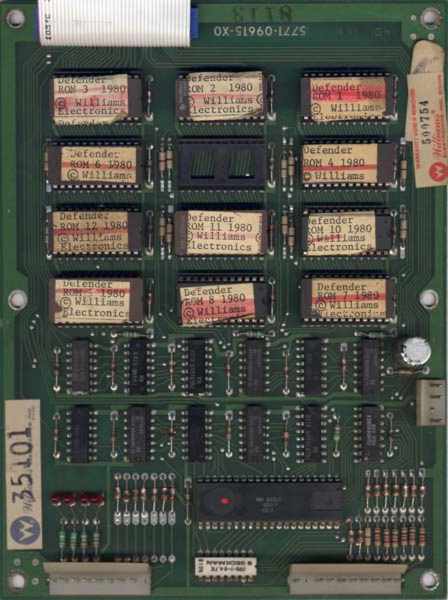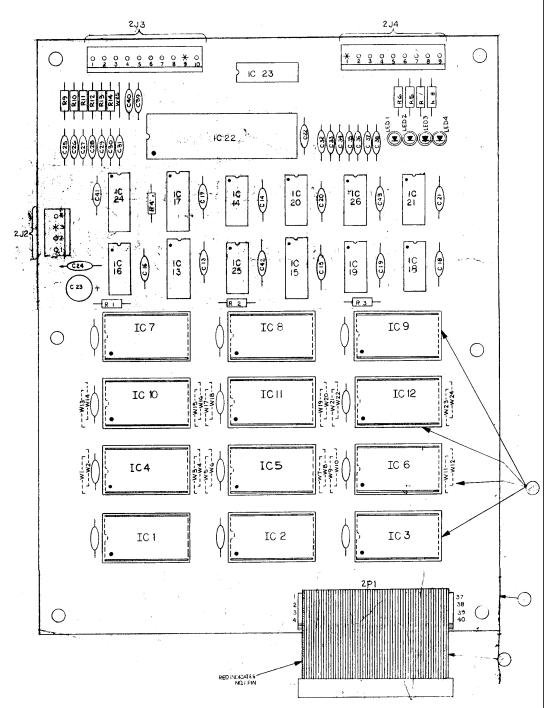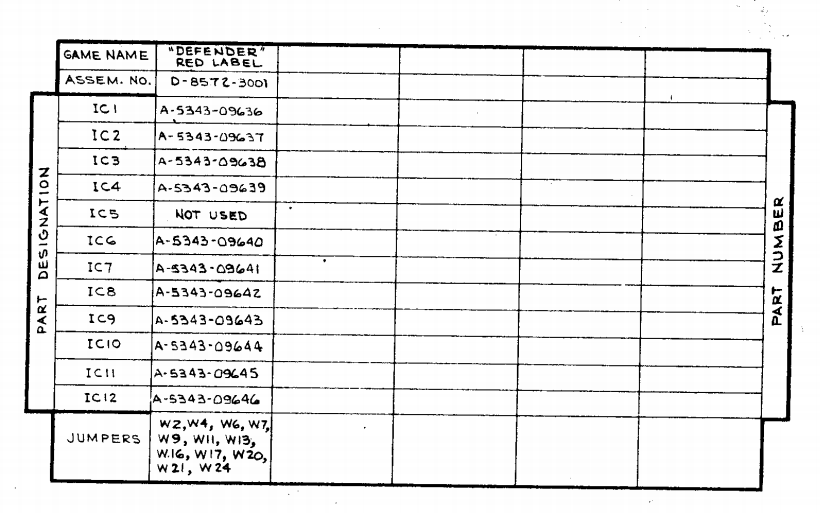Defender (1981) by Eugene Jarvis and Sam Dicker
This is the source code for the Williams arcade game Defender.
The source code can be assembled into the 11 rom files that would have been loaded onto the arcade cabinet's ROM board. Today, these rom files can be used to play the game in an emulator such as MAME.
- Build Instructions
- Play Defender
- Notes on the Source Code, ROM Files, and the Physical Circuit Boards
Build Instructions
Build Requirements
sudo apt install build-essentials wine python3 flexBuild the assembler toolchain
We use asm6809 to assembler the source code for the main game and vasm to compile
the sound module.
First you must run the following to set up the git submodules containing the assembler toolchain:
git submodule init
git submodule updateNow you can build the toolchain, as follows:
cd asm6809
./autogen.sh
./configure
make
cd ..
cd vasm-mirror
make CPU=6800 SYNTAX=oldstyle
cd ..Build Defender
To build the Red Label rom files (see below for more information on what these are), do:
make redlabelThese will get written to a directory called redlabel.
Play Defender
Once you've built defender you can now use the rom files in the redlabel directory to play defender on MAME. If you're on Ubuntu you can also install MAME with apt:
sudo apt install mameNotes on the Source Code, ROM Files, and the Physical Circuit Boards
About the source code
The game source code for Defender in src was originally retrieved from https://github.com/historicalsource/defender. It is the Motorola 6809 assembly language source code for the 'Red Label' version of the game.
The source code for the sound module was retrieved from https://github.com/historicalsource/williams-soundroms.
There were four versions of the game released: White Label, Blue Label, Green Label, and Red Label, in that order. Each release was a circuit board with the assembled code split across a number of different ROM chips, also referred to as 'ICs'. This image of the Red Label ROM board from Scott Tunstall's site gives you an idea of what such a board looks like:
If you compare this image to the file listing for the Red Label
roms you'll notice that the missing chip on the board
corresponds to a missing file defend.5:
[robert@mwenge-desktop defender-redlabel (master)]$ ls -al
total 64
drwxrwxr-x 2 robert robert 4096 Jul 11 10:32 .
drwxrwxr-x 8 robert robert 4096 Jul 11 11:02 ..
-rw-rw-r-- 1 robert robert 2048 Dec 24 1996 defend.1
-rw-rw-r-- 1 robert robert 2048 Dec 24 1996 defend.10
-rw-rw-r-- 1 robert robert 2048 Dec 24 1996 defend.11
-rw-rw-r-- 1 robert robert 2048 Dec 24 1996 defend.12
-rw-rw-r-- 1 robert robert 4096 Dec 24 1996 defend.2
-rw-rw-r-- 1 robert robert 4096 Dec 24 1996 defend.3
-rw-rw-r-- 1 robert robert 2048 Dec 24 1996 defend.4
-rw-rw-r-- 1 robert robert 2048 Dec 24 1996 defend.6
-rw-rw-r-- 1 robert robert 2048 Dec 24 1996 defend.7
-rw-rw-r-- 1 robert robert 2048 Dec 24 1996 defend.8
-rw-rw-r-- 1 robert robert 2048 Dec 24 1996 defend.9So each file defend.[x] corresponds to a matching chip on the board and
because there is a missing chip in slot 5 we have no defend.5 in the rom dump
listing.
In the Defender product documentation a
chart lists the part numbers for each chip and confirms that IC5 (i.e. defend.5) is unused:
When we assemble the Defender source with make redlabel we create a bunch of
object files and then split them across the 11 files to match the 11 in the Red
Label ROM dump listing above.
Eugene Jarvis left a slightly cryptic note to how we assemble the source in info.src:
TO ASSEMBLE THE DEFENDER MESS
RASM PHR2,DEFA2,DEFB2,AMODE0;-X (ELSE CREF SYMBOL OVERFLOW)
RASM PHR2,SAMEXPA7
RASM PHR2,DEFA2,DEFB2
TO GET THE DIAGS, CHAIN ALL.CF
LOAD IT ALL AND THEN PRAY IT WORKS
(NOTE: BEWARE OF ORDER OF LOADING
LOOK OUT FOR THE SELECTED BLOCK SHIT
DR J. 1/21/81
Since the RASM assembler is no longer available to us we use asm6809 instead. Fortunately this
does a good job of assembling the source faithfully and only very minor modifications to the source files are
required to produce binaries. We recreate the steps in Eugene's notes as follows:
# Build amode1 # The equivalent of: RASM PHR2,DEFA2,DEFB2,AMODE0;-X (ELSE CREF SYMBOL OVERFLOW)
./asm6809/src/asm6809 -B src/phr6.src src/defa7.src src/defb6.src src/amode1.src\
-l bin/defa7-defb6-amode1.lst -o bin/defa7-defb6-amode1.o
This is the main game code with the attract mode module assembled in. phr6.src is a file containing definitions,
while defa7.src and defb6/src contain the main game code; amode1.src contains the attract mode code.
We also have to build a version of this game code without the attract mode module:
# Build defa7 and defb6
# The equivalent of: RASM PHR2,DEFA2,DEFB2
./asm6809/src/asm6809 -B src/phr6.src src/defa7.src src/defb6.src\
-l bin/defa7-defb6.lst -o bin/defa7-defb6.o
The final module the notes mention is samexpa7 a bunch of explosion routines added by Sam Dicker:
# Build samexamp
# The equivalent of: RASM PHR2,SAMEXPA7
./asm6809/src/asm6809 -B src/phr6.src src/samexap7.src\
-l bin/samexap7.lst -o bin/samexap7.o
Eugene's notes are much less clear on how we go about assembling the reamining source files:
mess0.src
blk71.src
romf8.src
romc0.src
romc8.src
However the way he lists them in the notes turns out to provide a clue to the order in which they shoud be assembled:
PHR6.SRC 636 LINES
DEFA7.SRC 3,375 LINES
DEFB6.SRC 2,252 LINES
AMODE1.SRC 1,310 LINES
BLK71.SRC 723 LINES
SAMEXAP7.SRC 382 LINES
MESS0.SRC 955 LINES
ROMF8.SRC 692 LINES
ROMC0.SRC 925 LINES
ROMC8.SRC 839 LINES
We assemble the last four together in the order that they appear above:
# Build roms
./asm6809/src/asm6809 -B src/mess0.src src/romf8.src src/romc0.src src/romc8.src\
-l bin/roms.lst -o bin/roms.o
And we assemble blk71.src by itself:
# Build blk71
./asm6809/src/asm6809 -B src/blk71.src -l bin/blk71.lst -o bin/blk71.o
ROM Part Table with Corresponding Assembled Object Files
This table shows how the contents of each ROM chip relates back to the assembled code.
| ROM Chip | Part Number | File Name | Build Binary | Start Position in Build Binary | End Position in Build Binary |
|---|---|---|---|---|---|
| IC1 | A5343-09636 | defend.1 | bin/defa7-defb6-amode1.o | 0xb000 | 0xb800 |
| IC2 | A5343-09637 | defend.2 | bin/defa7-defb6-amode1.o | 0xc000 | 0xd000 |
| IC3 | A5343-09638 | defend.3 | bin/defa7-defb6-amode1.o | 0xd000 | 0xdc60 |
| IC3 | A5343-09638 | defend.3 | bin/samexpa7.o | 0x0000 | 0x02f8 |
| IC3 | A5343-09638 | defend.3 | bin/defa7-defb6-amode1.o | 0xdf59 | 0x0230 |
| IC4 | A5343-09639 | defend.4 | bin/defa7-defb6-amode1.o | 0xb800 | 0x0800 |
| IC5 | Not Used | ||||
| IC6 | A5343-09640 | defend.6 | bin/blk71.o | 0x0000 | 0x0772 |
| IC6 | A5343-09640 | defend.6 | bin/roms.o | 0xa778 | 0x0088 |
| IC7 | A5343-09641 | defend.7 | bin/roms.o | 0xa000 | 0x0800 |
| IC8 | A5343-09642 | defend.8 | bin/roms.o | 0x0000 | 0x0800 |
| IC9 | A5343-09642 | defend.9 | bin/defa7-defb6-amode1.o | 0x0000 | 0x0800 |
| IC10 | A5343-09643 | defend.10 | bin/roms.o | 0xa800 | 0x0800 |
| IC11 | A5343-09644 | defend.11 | bin/roms.o | 0x0800 | 0x0800 |
| IC11 | A5343-09644 | defend.11 | Unknown | 0x0800 | |
| IC12 | A5343-09645 | defend.12 | bin/defa7-defb6-amode1.o | 0x0800 | 0x0800 |
| IC12 | A5343-09645 | defend.12 | bin/defa7-defb6-amode1.o | 0xaee9 | 0x0117 |
Replicating this arrangement of the binaries is achieved by ChainFilesToRom.py in the
project's Makefile. It's a simple python script that extracts the relevant segments from each of the
binaries built in the bin folder when you run make redlabel.
Changes required for the source to assemble
There were a few modifications to the source required along the way to get this to work.
- Replacing macro arguments to make them compatible
asm6809,e.g.:
-NAPP MACRO \0,\1
- LDA #\0
- LDX #\1
+NAPP MACRO \1,\2
+ LDA #\1
+ LDX #\2
JMP SLEEPP
ENDM - Replacing the use of
$in label names, e.g.:
-INIT$V EQU HOFV+2
-HALLDV EQU INIT$V+2
+INITSSV EQU HOFV+2
+HALLDV EQU INITSSV+2- Replacing the use of '.' in label names, e.g.:
- LDY #.P1SCR ;START WITH PLAYER 1
+ LDY #P1SCR ;START WITH PLAYER 1- Work around the fact that
RASMseems to have allowed you to assemble code sections into overlapping memory segments. For example bothamode1.srcanddefa7.srcwant to assemble into position$C000in the ROM, meaning that one will overwrite the other. This explains why the main game files get assembled twice, once with attract mode (amode1.src) and once without: they wanted a binary with some segments overwritten with attract mode features and one without. We achieve this ourselves by modifying the source to assemble and place the attract mode code to position$2000in memory, and when we later split the object files into thedefend.xfiles pick the chunk of code we're interested in:
@@ -111,6 +111,8 @@ YSHIP EQU $5000
AMTYPE EQU 0
ORG $C000
+ PUT $2000
+
JMP HALLOF ;VECTORS
JMP SCNR- In
amode1.srcI had to replace a few hard-coded constant values to match what was in the binary:
diff --git a/src/amode1.src b/src/amode1.src
index 543cb7e..cdaeb1e 100755
--- a/src/amode1.src
+++ b/src/amode1.src
@@ -145,19 +147,19 @@ HALL1 STA PNUMB ;PLAYER NUMBER
HALL1A JSR P2SW
HALL1B LDB #$85 ;LIGHT BLUE LETTERS
STB PCRAM+1
- LDA #$FE ;TODAYS SOUND - PHANTOM
+ LDA #$3E ;TODAYS SOUND - PHANTOM
LDX #THSTAB ;TODAYS TOP SCORE
JSR CPXCY ;COMPARE
BHS HALL2 ;NOT THE BEST?
- LDA #$FD ;HIGH SCORE SOUND - TOCCATA
+ LDA #$3D ;HIGH SCORE SOUND - TOCCATA
HALL2 LDX #$CC02 ;SOUND PIAS
- LDB #$FF ;CLEAR LINES
+ LDB #$3F ;CLEAR LINES
JSR STBXBV
- LDB #$E4 ;SELECT ORGAN
+ LDB #$24 ;SELECT ORGAN
JSR STBXBV
-HALL3 DECB DELAY
+HALL3 DECB ;DELAY
BNE HALL3
- LDB #$FF ;CLEAR LINES
+ LDB #$3F ;CLEAR LINES
JSR STBXBV
TFR A,B
JSR STBXBV ;PLAY SOUND- Update the bit-shift and bit-wise comparison notation to be compatible with syntax expected by
asm6809, e.g.:
- LDX #WCURS!.$C35A ;CONFUSION
- LDD #WCURS!.$3CA5 ;MORE CONFUSION
+ LDX #WCURS&$C35A ;CONFUSION
+ LDD #WCURS&$3CA5 ;MORE CONFUSION
@@ -1206,7 +1208,7 @@ MT1 LDD BGL ;CALC SCANL
LDA STATUS
BITA #2 ;NO TERRAIN???
BNE MTX ;NONE
- LDA #SCANER!>8
+ LDA #SCANER>>8
LDY #STETAB ;ERASE TABLE- Comment out some directives not used by
asm6809, e.g.:
index d2d7212..86d4bf0 100755
--- a/src/blk71.src
+++ b/src/blk71.src
@@ -1,6 +1,6 @@
- TTL D E F E N D E R 1.0
- NMLIST
- NOGEN
+* TTL D E F E N D E R 1.0
+* NMLIST
+* NOGEN- This one may be worth investingating further. The code references
P1LASwhen it needs to beP1LATto match the Red Label binaries. Would be interesting to know if this sheds any light on the version of the source code as it looks very like a typo that was bug-fixed.
@@ -831,14 +831,14 @@ CSCX RTS
*DISPLAY LASERS
*
LDISP PSHS D,X,Y,U ;PLAYER 1
- LDX #P1LAS
- LDA .P1LAS
+ LDX #P1LAT ;Fixme was: #P1LAS
+ LDA P1LAS
BSR LDSP
LDA PLRCNT
DECA
BEQ LDPX
- LDX #P2LAS
- LDA .P2LAS
+ LDX #P2LAT
+ LDA P2LAS
BSR LDSP- I needed to modify the
KILPandKILOmacros to assembly properly withasm6809. Removing the addition of$to the argument in the macro itself and instead adding it before passing the argument:
-KILP MACRO \0,\1
+KILP MACRO \1,\2
JSR KILPOS
- FDB $\0
FDB \1
+ FDB \2
ENDM
-KILO MACRO \0,\1
+KILO MACRO \1,\2
JSR KILOS
- FDB $\0
FDB \1
+ FDB \2
ENDM
index 33665f5..3f4c5ac 100755
--- a/src/defb6.src
+++ b/src/defb6.src
@@ -73,13 +73,13 @@ UFONV4 ADDA #10
CLRB
LDA XTEMP+1
ADDD PLAYV
- ASRA DIVIDE ;BY 2
+ ASRA ; DIVIDE BY 2
RORB
STD OYV,X
UFONVX RTS
*UFOKILL
UFOKIL DEC UFOCNT
- KILP 0120,UFHSND
+ KILP $0120,UFHSND
RTS
*- Replace some single-quotes with double-quotes for compatibility with
asm6809, e.g.:
@@ -780,21 +780,21 @@ A28 FCC "SPECIAL ;FUNCTION/"
* DEFAULT HERE FOR NOW
*
DEFALT FCB $02,$12,$70 ;CRHSTD
- FCC 'DRJ'
+ FCC "DRJ"
FCB $01,$83,$15 ;CRHST1
- FCC 'SAM'
+ FCC "SAM"
FCB $01,$59,$20 ;THSTD2
- FCC 'LED'
+ FCC "LED"blk71.srchas to be assembled with 6309 extensions andSTX [,Y]has to be changed to the `COMF' instruction in order to get it to match with the ROM binaries.
./src/blk71.src:191: TTER03 COMF ;Was: STX [,Y] ;FAST OUTPUT- In a few cases I've had to replace the values of constants in the code to match the ROM binaries. These are:
./src/romc0.src:78: FDB $D9FF ;Fixme was: $FFFF
./src/defb6.src:2170: FDB $0000,$00FE,$C300 ; Fixme: $C300 was $6600
./src/mess0.src:68: FDB $5BFF ;Fixme was: $FFFF
./src/mess0.src:654: FDB $84FF ;Fixme was: $FFFF



